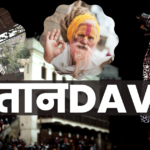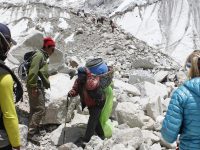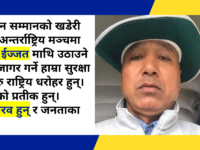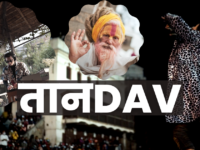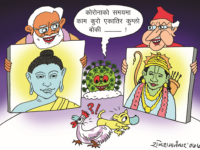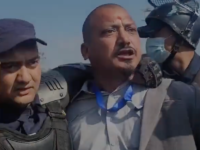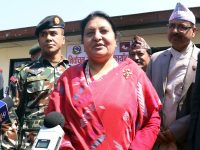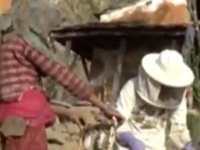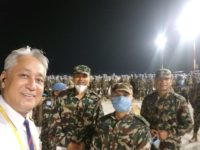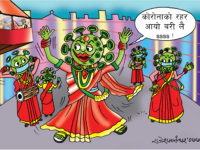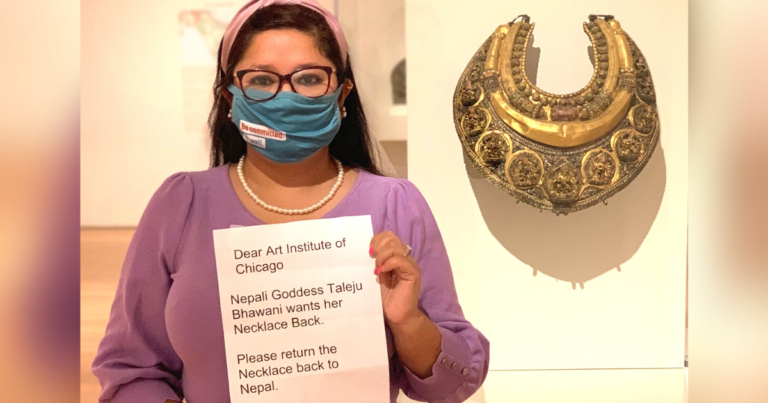An idol is not just a piece of stone art. For the spiritually ingrained mind of Nepalese, an idol is God or Goddess itself. Nepal is the land where every family has its own Gods called Kul deuta, where the Gods reside amidst the people in temples throughout the human settlements in villages and particularly in Kathmandu valley. And even now, people honor the god Kumar by placing his symbols at the entrance of their homes.
That is why It is not incomprehensible for any Nepali to relate to the emotional response of an Assistant Professor Dr. Sweta Gyanu Baniya when she came across an ancient Nepali artifact in Chicago. She became emotionally overwhelmed and started praying spontaneously, as any devote Nepali would. She felt the injustice of the situation from her heart so she photographed the golden copper necklace that used to adorn Goddess Taleju Bhawani in Kathmandu until 1970. Then she shared on Twitter, which started a movement for its repatriation. The Nepal government officials took notice and contacted the Art Institution of Chicago, which has yet to respond to the query, and the request for its return. New-in-24 reports that the Metropolitan Museum in New York returned several statues of the god Shiva in 2018. The same is expected of all the artifacts that disappeared from Nepal since 1950.
We haven’t heard anything yet. Just want to remind that this holy necklace should be returned and we hope you will listen to us @artinstitutechi
Thank you, Dr. Abhilasha Shrestha @ashrestha for accompanying me and taking my photos and being my moral support. pic.twitter.com/SYJML0E0HE
— Dr. Sweta Gyanu Baniya (@Sunkesharee) December 11, 2021
What this incident is a tip of an iceberg. Upon delving behind this issue, we discover that drug and cultural artifacts smuggling used to the biggest criminal activities in Nepal back in the 1970s. It was a big black eye for the Panchayat regime back then. This nefarious trade became public knowledge when an unseemly incident took place in 1986. A firebrand fearless journalist named Padam Thakurathi was shot in the head when he was sleeping. The intent was to kill him, no doubt.
Gold necklace of king Pratāp Malla (r. 1641-74)
NepālmandalaMalla donated this ornament to his clan goddess (kuldevi) Tulajā Bhawāni. The king used to wear this in #Tantra rituals. It is mentioned as necklace of the "king of kings, lord of kings, lord of.. (1/2)#Newar #Nepal pic.twitter.com/zhyIjCmrJv
— Sarvāmnāya Newah Veda-Tantra (@NewahVeda) February 15, 2021
When the mystery unraveled, it implicated the higher ups in the echelon of power in Nepali politics and even involved members of the royal family. Mr. Thakurathi was the only journalist who stood for the truth and published about such criminal activities that accused the involvement of top level police officers, bureaucrats in collusion with the royals.
I took this video yesterday at Art Institute of Chicago where stolen piece of our Taleju Bhawani (our Goddess ) from Nepal is openly displayed @artinstitutechi pic.twitter.com/20vsrsIuNx
— Dr. Sweta Gyanu Baniya (@Sunkesharee) June 12, 2021
He has even said that there was not a single original idols left in the temples. Not only the idols but also the sacred books and artistic tundals were also smuggled through the airport where none of the royal family members had to undergo any inspection. It was a case of “absolute power corrupts absolutely.” This reality has been forgotten by the current generation. Thakurathi had read the news about Nepal officials to 1984 Olympics being arrested in the USA and published the same in Nepali newspaper. That was too much for the power to digest. Consequently, his murder plot was hatched and implemented.
The mystery behind the disappearance of cultural and spiritual artifacts of Nepal has one simple explanation. There was a sinister hand of the power-holders of the Panchayat era taking advantage of their hold in all the administrative agencies.
In its report, Al Jazeera reports the email it received from an activist group working for the repatriation of such stolen artifacts: “We have seen empty temples, empty shrines, empty pedestals and torn toranas everywhere” in the Kathmandu valley.” Fortunately, Nepalese are now spread all over the world and they have far more capabilities to discern and support preservation of our natural heritage that were sold off by the ruling class in the 1970s and 80s.
As the movement picks up steam for repatriation of the colonial era loot from the African and Asian countries to the Western nations, the world is reacquainted of the inhumane and savage policies of the West towards the more ancient civilizations. We can have hope that the current artifact in question, the necklace of Goddess Taleju, will also be returned to the temple in the near future. For that to happen we have to increase pressure in the social media, and increase our vigilance as shown by Dr. Sweta Gyanu Baniya, who should feel proud that she made a great contribution in an international struggle to right the wrongs done by the corrupt powerful people of Nepal during the Panchayat era, giving bad name to the system.
Such corruption resulting from unchecked power can be attributed to the people’s revolt against that system, not only the foreign designs that are cited by learned scholars and analysts. It is always up to the vigilant citizens to wake us up. May there be more such actively involved Nepalese.
The writer is a graduate of Arizona State University in Political Science. He is working as a social activist and motivational speaker for students across Nepal since 2007.
The views and opinions expressed in this article are those of the author and do not necessarily reflect the official policy or position of Nepalisite.


